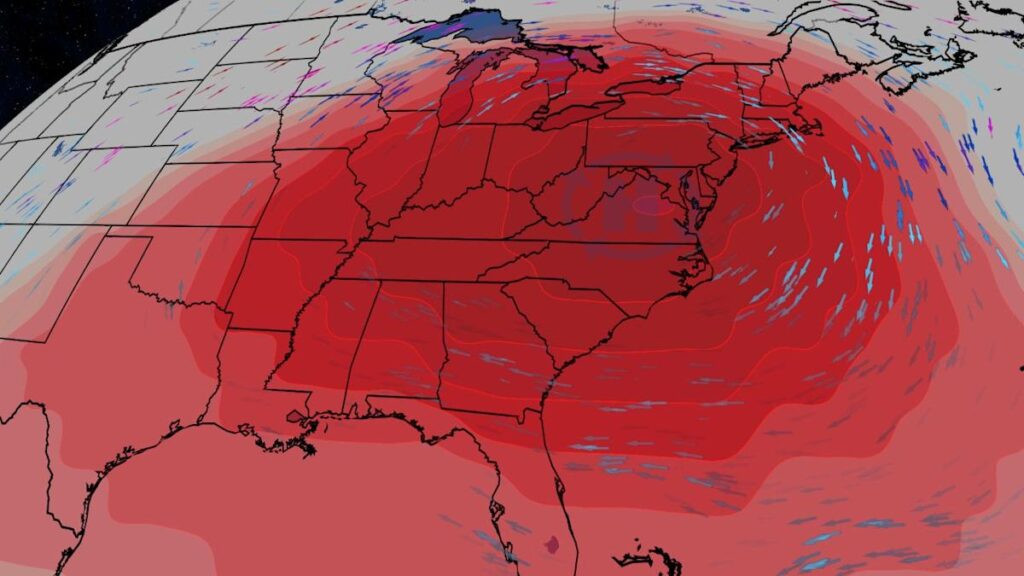A dangerous, widespread heat wave will bake the central and eastern U.S., bringing the hottest temperatures of the year and uncomfortably muggy air to the Midwest and Northeast that in some areas could last into much of next week.
Already, daily record highs were set Thursday in Salt Lake City (104 degrees), their first triple-digit high of the year.
(MORE: Download The Weather Channel App To Track The Heat Dome)
Here are the main takeaways from the forecast:
Heat Alerts
– The National Weather Service has already issued extreme heat watches, warnings and heat advisories for large swaths of the central and eastern U.S., as you can see in the map below. Some cities in these alerts, including Omaha, the Twin Cities, Chicago, Kansas City, St. Louis, Detroit, Cincinnati and Pittsburgh.
– The highest level heat alerts are now called “extreme heat” watches and warnings. You can find more about those changes here. These alerts indicate that heat illnesses are expected to spike when they are in effect. Minneapolis and Omaha are just two of the cities that are already expected to see dangerous conditions.
(TRACK THE HEAT: Temperatures | Heat Index)

Heat Timing
Here’s when we expect the worst of the heat:
– Plains and upper Mississippi Valley: Lasting through Sunday
– Rest of Mississippi Valley: Could last through much of next week
– Rest of Midwest: Beginning Saturday, with relief Tuesday in the northern Great Lakes, but heat could last much of next week in the Ohio Valley
– Northeast: Ramps up Sunday, with some relief in New England, eastern Great Lakes by Wednesday. Mid-Atlantic and Appalachians heat could last much of next week.
(MAPS: 10-Day Forecast US Highs/Lows)
How Hot?
– Highs in the 90s will spread over much of the country east of the Rockies, except for the far northern tier.
– Dozens of locations, especially in the Northeast, will be within striking distance of daily record highs, especially Sunday through Tuesday.
– A few locations could approach or top 100 degrees during the heat wave, including Denver Friday and Saturday, which only happens twice a year on average. Boston, New York City, Philadelphia and Washington, D.C. could flirt with the century mark during the peak of the heat wave next week. Some of those locations could do so multiple days during the heat wave.
– New York’s Central Park hasn’t reached 100 degrees since July 18, 2012, according to the National Weather Service. Philadelphia hasn’t reached 100 degrees in June since 1994. Boston’s last 100-degree high was on July 24, 2022.
(MORE: Should You Turn Off Your A/C Or Leave It On When You Leave Home?)

Forecast Highs Next Week
Humid, Too
– Oppressive humidity will accompany the heat wave.
– This will particularly be the case in the mid-Mississippi and Ohio Valleys, but also into the upper Mississippi Valley, Great Lakes and at least parts of the mid-Atlantic and Northeast.
– That means the heat index, or feels-like temperature, will be in the triple digits on one or more days for some cities in the Midwest and Northeast this weekend into early next week.
– This also means that overnight temperatures will not cool off or provide any relief from the daily heat.
(MORE: Why The Dew Point Temperature Matters)

Forecast Dew Point
What You Should Do
– Heat is the number one weather killer in the U.S., with hundreds of fatalities each year.
– The combination of heat and humidity lingering into the night for several days in a row could be dangerous for those without access to air conditioning, especially in the cores of larger cities.
– Check on family, friends, the elderly and those with chronic illness who live without access to air conditioning.
– If possible, avoid being outdoors for long in the peak heat of the afternoon.
– If not, take frequent breaks, avoid strenuous activity, drink more water than usual and wear loose, lightweight clothing.
(MORE: Heat Advice From An ER Doctor)

heat risk forecast

heat risk forecast
Why So Hot?
– This heat wave will be triggered by a change in the jet stream pattern.
– Specifically, a strong bubble of high pressure aloft known as a heat dome will develop over the eastern U.S.
– Sinking air near the center of this heat dome suppresses clouds, allowing the intense sunshine this time of year to heat the ground and air above it most efficiently.
– Southerly and southwesterly winds will also tap hot and humid air from the South into the Midwest and Northeast.
– This heat dome will only slowly weaken and “flatten out” in the East in the week ahead.

Heat wave forecast East Midwest
Jonathan Erdman is a senior meteorologist at weather.com and has been covering national and international weather since 1996. Extreme and bizarre weather are his favorite topics. Reach out to him on Bluesky, X (formerly Twitter) and Facebook.

